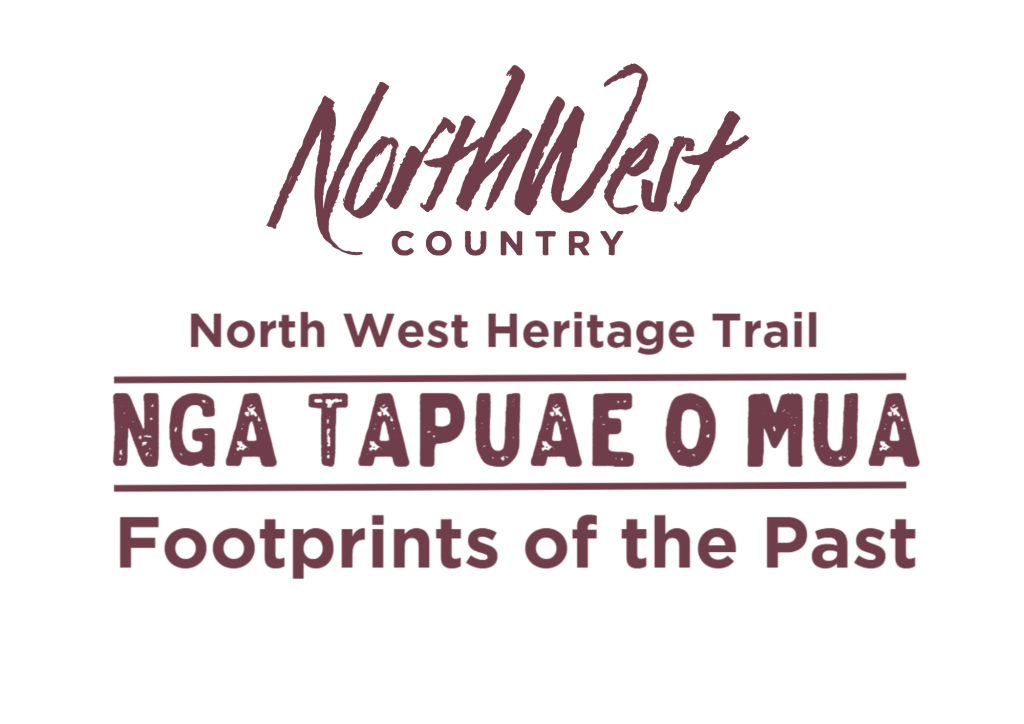
KO TE KAIPARA
Ko te wai ko te puna ora nō te ao whānui. Hoinā te pūtake o te ingoa Te Awaroa. Kei a Tangaroa he maha ngā tūmomo kai moana i roto i tōna whare. E takoto noa nei ngā ara waka me ngā ara kaipuke, hoinei hoki ngā riu o ngā taniwha. Kua tahuringia te tinitini o ngā kaipuke e te Kaipara. “Tapora, tahuri waka, whakarere wāhine”
Mehemea horekau he awa to taua, kei hea te taone? Ko Kaipara te awa, ahakoa tēnā ināianei he awa whāiti noa ake taua awa, erangi ki mua o te wā totope rākau, ko tētahi awa whānui kē. I ārahi te ara awa nei i ngā tāngata, hei ara ki te tuku kai, ngā tuporo hoki i kawe mai nō wāhi kē. I hoe hoki ngā ope taua i te awa ki ngā pakanga rongonui o mua.
THE KAIPARA HARBOUR
Water is the source of life for the natural world. Te Awaroa, Helensville exists for that reason. Tangaroa (god of the sea) has provided the seafood in the Kaipara. It provides a pathway for waka (canoes) and ships. However, there are also taniwha (powerful supernatural beings) in the Kaipara and there have been a great number of shipwrecks.
Without the river there would be no town. The Kaipara River has served as a pathway for people, food and kauri logs to and from other places. It has also served as a pathway for opposing armies.
Before the wholesale felling of timber, the river was much wider than it is now.
Te Kaipara – The Kaipara Harbour
In the 1400s Kahumatamoe, a chief of the Arawa people, came to the area to visit his nephew in Poutu. He was given cooked root of the para fern at a feast held for him. He was so taken that he gave the name Kai-para to the district.
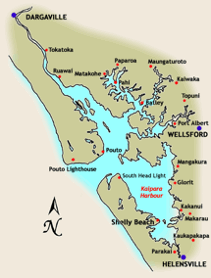
Map of Kaipara courtesy of helensville.co.nz
The vast Kaipara Harbour is one of the largest harbours on Earth. It covers 947 square kilometres at high tide and has numerous estuaries. It is separated from the Tasman Sea by two large sandbank peninsulas. The 800 kilometres of coastline has large tidal mudflats and is fed by five rivers and over a hundred streams.
Estuaries were favoured food-gathering spots and sites for settlement for Māori. They provided safe, sheltered waters with an abundance of fish, shellfish, and birds for eating. The rivers provided great travel paths to inland areas and their wealth of resources.
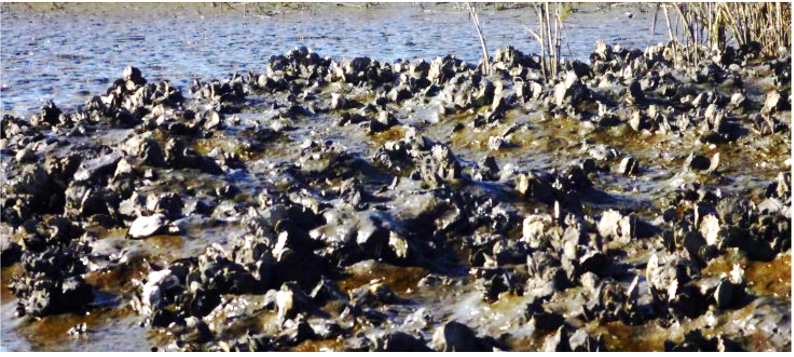
Mud Oysters
Sadly, as European settlement grew, farms, towns and cities began to pollute the estuaries. Deforestation caused surface erosion, lowered the ability of the soil to soak up the water and increased the silting up of the rivers. The land was also filled in for projects such as sewerage works, rubbish dumps and reclaimed pasture.
The entrance to the Kaipara harbour has shifting sandbars and is notorious for its risks to shipping. The area is known as the “Graveyard” and was especially feared. It has been the site of around 110 shipwrecks.
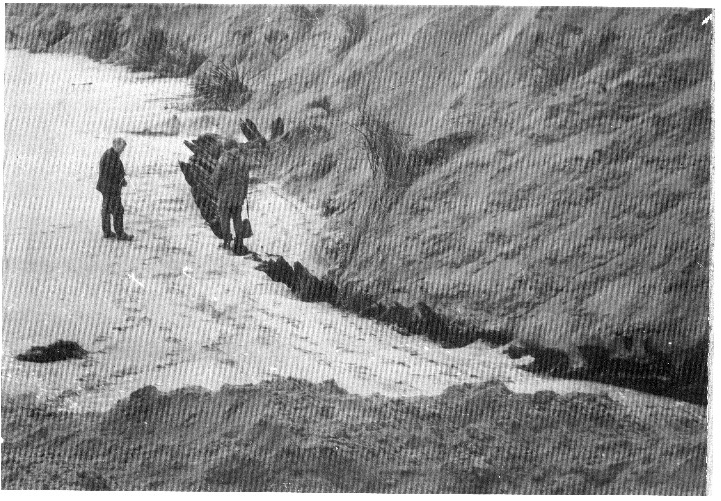
At the wreck of The Seagull – McLeod’s ship – courtesy of Helensville Museum
Māori tell of the ocean-going waka (canoe) Māhuhu-ki-te-Rangi which voyaged from Hawaiki to Aotearoa (New Zealand). It overturned on the northern side of the entrance and its commander, Rongomai, drowned.
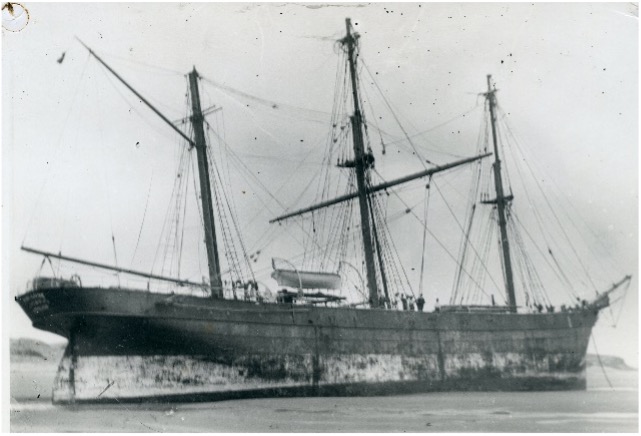
The Kinclune – wrecked 1904 – courtesy of Helensville Museum
Samuel Polack described his encounter with the harbour mouth in 1831: “The breaks were dashing on several sandbars in an awful manner, about three miles from the land. The late westerly gale caused the fearful commotion of the rolling waves to bound on these sea sand spits, dashing the surf to an unusual height. No vessel, of any size or shape, could at this time have entered the Kaipara; instant shipwreck, into a thousand pieces, would have been the result”.
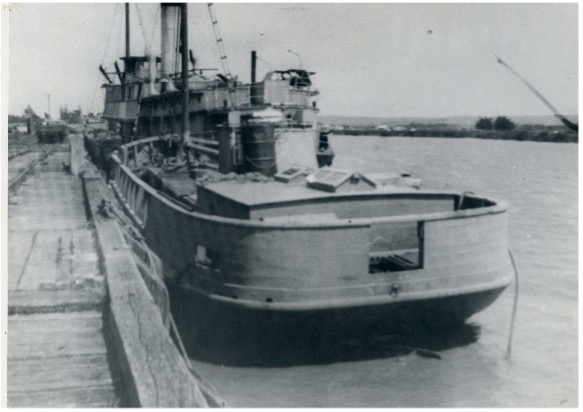
MV Te Tui moored astern of SS Ruawai at Helensville Wharf – courtesy of Helensville Museum
Despite the perilous bar at the harbour entrance Te Awaroa (Helensville) became a busy port from the 1860’s, shipping thousands of tonnes of kauri timber and gum. From 1863 Te Awaroa became a major port for not only the timber trade, but also for shipping services around the Kaipara, to West Coast ports and Sydney, Australia. Completion of the rail link from Tamaki Makaurau (Auckland) to Dargaville in 1942 brought about the end of the ferry service and shipping via the harbour. The Kaipara port was officially closed in 1947.
Further reading from Papers Past:
People & Their Stories…
Flora Thirkettle
(née Smith), 1928 – 2021
As a young widow with seven children, Flora Thirkettle, through humility, hard work, and sheer determination won herself an important place in harbour life and legend.
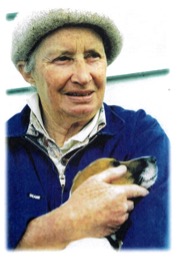
Courtesy of Thirkettle family
At age 19 she married George Thirkettle, a shark fisherman at Whangaroa. They fished there for ten years until George became unwell and they made plans to move to Australia. Unfortunately, Flora’s husband died in Auckland and she had to make some sudden decisions about the future. Her oldest child was ten and the youngest, nine months old. She wanted independence and a place of her own.
Flora began her life on the Kaipara after finding a house for sale in Te Awaroa. It was right on the river, complete with a launch (The Olive), a dinghy, a pair of oars and two nets. It wasn’t easy, fishing on the Kaipara is hard. Winds can change conditions dangerously quickly and the harbour has a 14ft rise and fall on the tide. There was a lot of trial and error in learning where and when to go. There were no other women fishing for a living on the Kaipara at that time. In Flora’s own words “The men just sat on the side, to see whether you sank or swam.” Flora was regarded with suspicion and reserve by the fishermen.
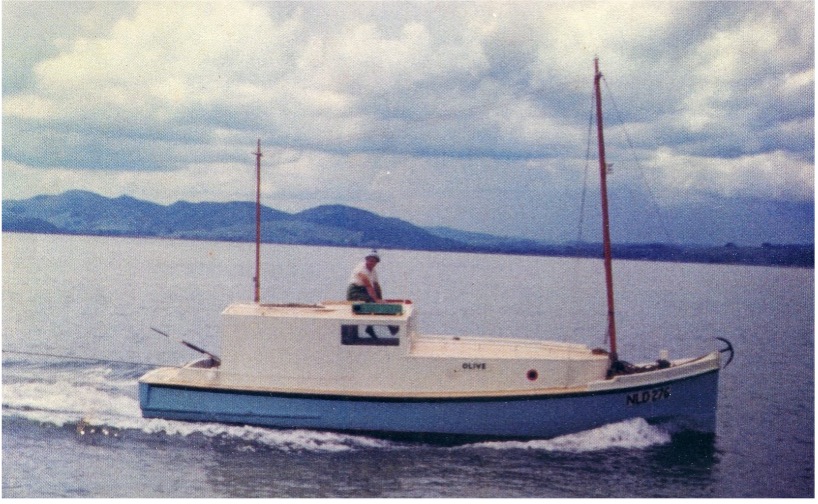
Flora Thirkettle and Norma McCathie with the shipwreck map behind them 1997 – courtesy of Helensville Museum
Fishing was a whole family affair. It had to be fitted around the children’s schooling. The Thirkettles became a real do-it-yourself family. The older children learned to manage the boat while their mother rowed out in the 16ft dinghy to set and then bring in the nets. Being of an independent nature, Flora did much of her own maintenance. She stripped down and reconditioned Olive’s 40 hp diesel motor, and replaced planks and ribs, and cabin fittings.
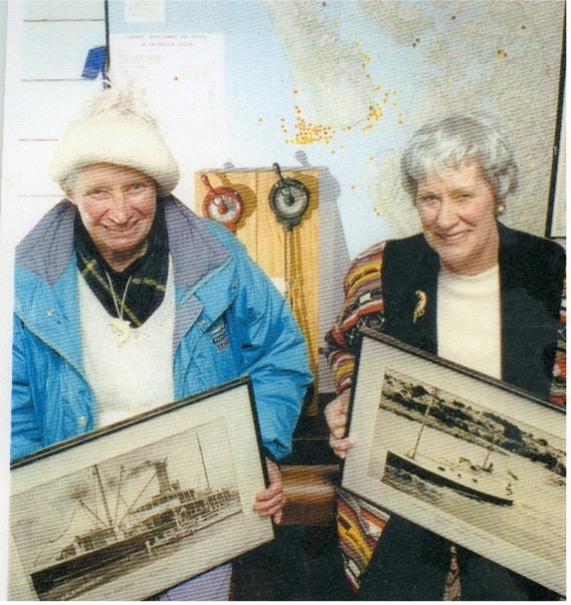
Flora on the Olive – courtesy of Helensville Museum
Flora recalled that when she started, the net rope was made of flax and was very hard on one’s hands when hauling in. She had the first two nylon nets on the harbour simply because that’s what she bought with the property. These were not popular with other fishermen then, as knots kept slipping and holes in the mesh got bigger! Flora worked out a suitable knot that would hold, and her net-making was in demand from her family and others as far away as Samoa and Tonga.
In 1965 Flora was accepted as the only woman into the Aotearoa (New Zealand) Voluntary Coast Guard Service. At the time the Tamaki Makaurau Coast Guard officials believed she was the only seagoing woman member of the Service in the world. Finally, being accepted by the older harbour users, Flora acknowledged that she was very grateful for their help at times.
As well as bringing up her own children Flora was a foster mother to many others. Her philosophy was “There’s always room for one more” and was surprised that they all still came back to see “Na Na”.
Listen to Flora’s Story on Radio New Zealand: Flora Thirkettle, Fisherwoman Spectrum | RNZ
Pokopoko-whiti-te-ra-herehere-taniwha
Nā Leigh Bosch i tuhutuhi:
Ko wai o koutou kāhore anō kia rongo ki ngā kōrero mō Pokopoko-whiti-te-ra. He tupuna rongonui ia nō Ngāti Whātua. He maha ngā putanga kōrero e pā ana ki a ia. Kotahi noa te putanga.
Ko Pokopoko-whiti-te-ra tōku tupuna. Ko ia he mokopuna o Haumoewārangi. He tangata rongonui ia, nō te mea he tangata houhanga rongo ia. Mehemea kua roa kē te maungārongo, i kīa “hei te maungārongo o Pokopoko-whiti-te-ra”.
Ko tētahi atu ingoa o Pokopoko-whiti-te-ra, ko Te Pokopoko-herehere-taniwha, nō te mea he tangata momohu ki te hereherenga o ngā taniwha. I hopungia kupenga ngā taniwha e ia.
I tētahi rā i mua i haere he ope taniwha ki Te Kaipara. I raupatua te ope taniwha e Pokopoko, hāunga a Niwa rāua ko Āraiteuru. Ka puta te ihu o aua taniwha ki Te Hokianga. I aruarungia aua taniwha e Pokopoko ki Te Hokianga, ā, i whakamatengia e ia aua taniwha, arā ko Niwa rāua ko Āraiteuru. He toa nui ia. “Ko Te Pokopoko o Rotu, ko Te Aute te whawhea,” tēnei he whakataukī mō te toa ki te whawhai.
I te matenga o Pokopoko, i rumakina ia e tōna iwi ki te pūahatanga o Te Kaipara, pērā me tāna hiahia. Mea rawa ake, he taniwha kaha ia. I muri i te mātukuria ia e tētahi tōhunga, i hunaia e ia te pā o Ōkāka. He taniwha nanakia ia.
I hiahia a Pokopoko kia whakamatengia te tino taniwha o te Kaipara, ko Rangi-Riri-Rakau, ā, i whawhai rawa ake nei rāua. Ka haongia a Rangi-Rere-Rakau e Pokopoko. I huakina e ia a Rangi-Riri-Rakau, ēngari, i whakawātea a Rangi-Rere-Rakau, i toa ia, ā, ka hinga rawa a Pokopoko. Kāore i kitea anō ia. E whakakarekarengia ana te moana o Kaipara, ā, e kī ana ngā tāngata “titiro ki ngā ngaru o Pokopoko” ināianei tonu. Ka taea e tētahi te kite a Rangi-Riri-Rakau ināianei engari he tiramaka tēnei kitenga.
I ngā tau whakamutunga o tōna koiora, i kauanuanutia ia e ngā iwi katoa. He nui te mana o Pokopoko. I muri i tōna hemonga i aru ia i te hira, taihoa ā kua hinga rawa.
Ko tēnei te kōrero mō Pokopoko-whiti-te-ra-herehere-taniwha. He kōrero tēnei o te māia, te pāuaua, te whakakake, te whakahīhī, te apo mana hoki. I hinga te taniwha nō te whakakakenga. Ākene pea he whakatauki “Te whakakakenga o Pokopoko”.
Ākene pea i hinga ia ki te whawhai ki Otaua, ā, i nehua ia ki a Pangaru; heoi he pai tēnei putanga ne?
Whakatauki: Ko Pokopoko te taniwha
Ko Rangiriri te rakau whakangautai
Ko Hoeroa te ngaru
Ko Mahuhu-o-te-rangi te waka
Ko Ngāti Whātua te iwi
One version as told to, and by, Leigh Bosch:
Who among you hasn’t heard the stories about Pokopoko-whiti-te-ra? He is a famous ancestor belonging to Ngāti Whātua. There are many versions of his exploits and this is just one of them.
Pokopoko-whiti-te-ra (Pokopoko who makes the sun shine) was the grandson of Haumoewārangi. He was famous because he was a renowned peacemaker. A lengthy time of peace was referred to as the peace of Pokopoko-whiti-te-ra.
Another name of Pokopoko’s was Te Pokopoko-herehere-taniwha (Pokopoko who catches taniwha), because he was also known as someone who caught taniwha (supernatural beings) with ropes.
Once, when an army of taniwha came to the Kaipara Pokopoko caught them all except for Niwa and Āraiteuru. These two taniwha escaped back to the Hokianga and Pokopoko pursued them. He was a mighty warrior.
When Pokopoko died, his family gave him a sea burial at the Kaipara Heads, as was his wish. Soon, he had become a strong taniwha. When a tohunga (person with strong spiritual abilities) put a curse on him he destroyed a pā (a fortified village) at Ōkākā (near Shelly Beach). He had become a taniwha dangerous to his own people.
Pokpoko wanted to be the strongest taniwha is the area and challenged Rangi-Riri-Rakau (the strongest taniwha in the Kaipara). They fought fiercely, and Pokopoko caught Rangiriri but Rangiriri escaped the ropes that held him. He then beat Pokopoko severely.
Pokopoko disappeared for many years but Rangi-Riri-Rākau continues to patrol the Kaipara. When the seas are rough, they are referred to by many as the “waves of Pokopoko”. Pokopoko now resides in Makarau.
Pokopoko the man died in a battle at Otaua and many believe he was buried in Pangaru – but this version has a lot more twists and turns.
Pokopoko is the taniwha
Rangiriri is the tree that strikes
Hoeroa is the wave
Mahuhu-o-te-rangi is the canoe
Ngāti Whātua are the people
1. S Percy Smth. The History of Otakanini Pa, Kaipara. Transactions and Proceedings of the Royal Society of New Zealand, Volume 28, 1895, page 41
2. Te Matenga o Te Rev. Karewini Waiti. Wananga, Volume 5, Issue 28, 13 July 1878, p 350
3. Ngā kupu o Herby Skipper – he kaumātua nō Te Uri-o-Hau.
4. James Cowan, The Maori yesterday and today, 1930, p 219-220
5. Te pūranga tuhituhi o Ani Pihema kei roto i Te Whare Taonga o Te Awaroa.
6. Ngā kupu o ngā kaumātua o Te Kotahitanga o Kaipara Kaumatua Rōpu.
7. Te waka Taua “Mahuhu o te Rangi” nā Weretapou Tito pgs 1 & 2
